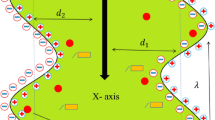Abstract
Nanoparticle technology is starting to be explored by several groups worldwide in the petroleum industry, with potential applications of magnetic nanoparticle injection ranging from monitoring the progress of hydraulic fracturing jobs to enhancing oil recovery. However, there is currently a little published information regarding the optimum conditions for the transport of dispersed magnetic nanoparticles through reservoir material. Magnetic nanoparticles have a tendency to aggregate together, potentially blocking pore connections and degrading reservoir quality. We report results of initial experiments designed to determine the ideal conditions to transport superparamagnetic nanoparticle suspensions through simulated unconsolidated core material. We used a non-metallic flow cell and integrated magnetic susceptibility sensor technique to quantify the transport of the nanoparticle suspensions. The flow cell was made of an acrylic material and allowed simultaneous magnetic susceptibility monitoring at various positions along the cell whilst the flow experiments were taking place. Such “in-line” quantitative magnetic susceptibility monitoring of the nanoparticle suspensions during a fluid flow experiment represents a significant step forward in characterization techniques. Simultaneous magnetic susceptibility monitoring is not possible using traditional stainless steel flow cells. The new flow cell is also transparent, allowing visual observation of the progress of the nanoparticle suspensions. We describe the effect of different dispersants, sonications, injection rates, permeability of the porous media and nanoparticle types on the transport of the nanoparticle suspensions. The flow cell and magnetic monitoring system have several other potential applications, including simultaneous monitoring of fines migration along the length of a core plug during various fluid flow experiments.










Similar content being viewed by others
References
Abrams, A.: Mud design to minimize rock impairment due to particle invasion. J. Pet. Technol. 29(5), 586–592 (1977)
Barron, A.R., Tour, J.M., Busnaina, A.A., Jung, Y.J., Somu, S., Kanj, M.Y., Potter, D.K., Resasco, D., Ullo, J.: Big things in small packages. Oilfield Review. December issue, 38–49 (2010)
Darko-Kagya, K., Reddy, K. R.: Monitoring nanoiron transport in porous media using magnetic susceptibility sensor. Proceedings of the 6th International Congress on Environmental Geotechnics, New Delhi, India, Nov 8–12, pp. 693–698 (2010)
Dunlop, D.J., Ozdemir, O.: Rock Magnetism: Fundamentals and Frontiers. Cambridge University Press, Cambridge (1997)
Fogden, A., Kumar, M., Morrow, N.R., Buckley, J.S.: Mobilization of fine particles during flooding of sandstones and possible relations to enhanced oil recovery. Energy Fuels 25(4), 1605–1616 (2011)
Ivakhnenko, O.P., Potter, D.K.: Magnetic susceptibility of petroleum reservoir fluids. Phys Chem Earth 29, 899–907 (2004)
Johnson, K.: Advances in nanotechnology hold huge potential promise in upstream applications. The American Oil and Gas Reporter. July issue, 112–123 (2010)
Khan, M. M.: A laboratory study of the effect of ionic strength on stability of nanoparticle suspensions using a magnetic technique. M. Eng. project report, University of Alberta, pp. 31 (2012)
Khan, S.: A laboratory study of the stability and flow of nanoparticle suspensions through porous media using magnetic techniques. M.Sc. thesis, University of Alberta, pp. 170 (2012)
Kumar, M., Fogden, A., Morrow, N.R., Buckley, J.S.: Mechanisms of improved oil recovery from sandstone by low salinity flooding. Petrophysics 52(6), 428–436 (2011)
Lees, J.A., Flower, R.J., Ryves, D., Vologina, E., Sturm, M.: Identifying sedimentation patterns in Lake Baikal using whole core and surface scanning magnetic susceptibility. J Paleolimnol 20, 187–202 (1998)
Nassar, N.N., Husein, M.N., Pereira-Almao, P.: Ultradispersed particles in heavy oil: Part II, sorption of \(\text{H}_{2}\text{S}_{(g)}\). Fuel Process Technol 91, 169–174 (2010)
Potter, D.K.: Magnetic susceptibility as a rapid, non-destructive technique for improved petrophysical parameter prediction. Petrophysics 48(3), 191–201 (2007)
Potter, D.K., Ali, A., Imhmed, S., Schleifer, N.: Quantifying the effects of core cleaning, core flooding and fines migration using sensitive magnetic techniques: implications for permeability determination and formation damage. Petrophysics 52(6), 444–451 (2011)
Acknowledgments
The support of a grant from nanoAlberta to D. K. P. is gratefully acknowledged. The support of a Natural Sciences and Engineering Research Council (NSERC) Discovery Grant to D. K. P. is also gratefully acknowledged. Some of the work in this paper was presented in preliminary form at the International Symposium of the Society of Core Analysts (SCA) held in Aberdeen, Scotland, UK, 27–30 August, 2012, and we thank the SCA for their policy of not retaining the copyright on SCA conference papers.
Author information
Authors and Affiliations
Corresponding author
Rights and permissions
About this article
Cite this article
Khan, S., Potter, D.K. & Kuru, E. Quantifying the Transport of Superparamagnetic Nanoparticles in Porous Media Using an Acrylic Flow Cell and Integrated Magnetic Susceptibility Sensor Technique. Transp Porous Med 106, 691–705 (2015). https://doi.org/10.1007/s11242-014-0420-6
Received:
Accepted:
Published:
Issue Date:
DOI: https://doi.org/10.1007/s11242-014-0420-6




